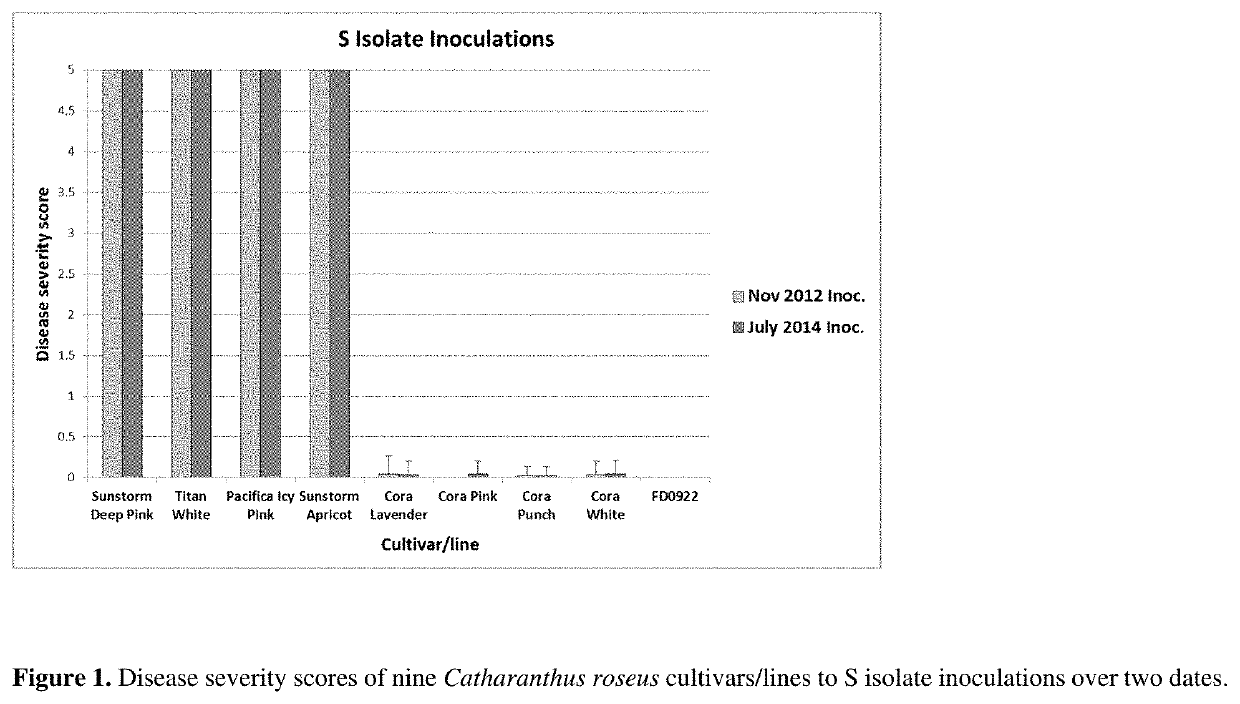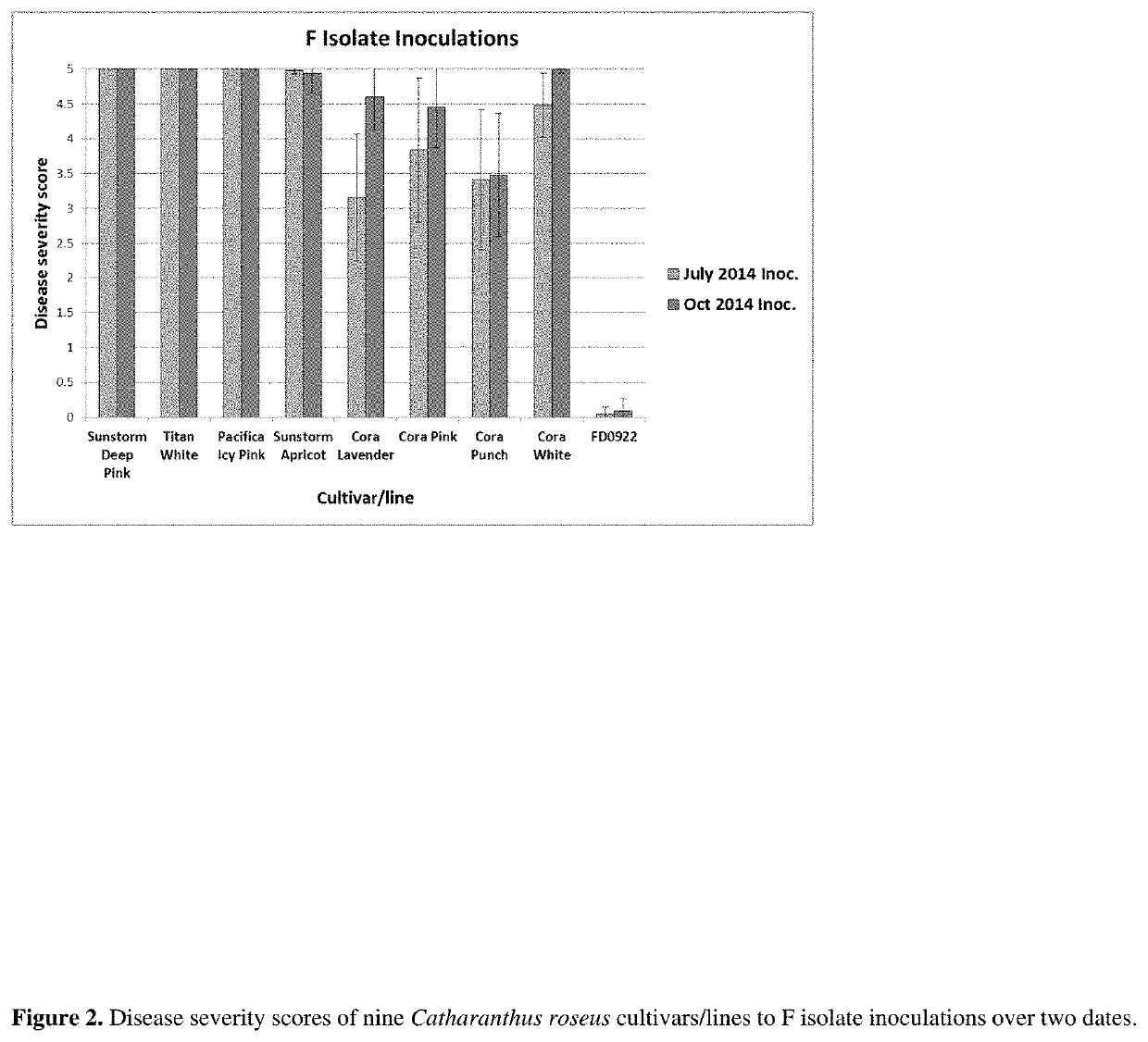Novel phytophthora resistant catharanthus roseus plant
a technology of catharanthus roseus and resistant plants, applied in the field of catharanthus roseus plants, can solve the problems of inability to cure plants infected with this pathogen, root rot, stem and foliage blight,
- Summary
- Abstract
- Description
- Claims
- Application Information
AI Technical Summary
Benefits of technology
Problems solved by technology
Method used
Image
Examples
example 1
[0069]Resistance Breeding
[0070]The Cora series of C. roseus was introduced as resistant to P. nicotianae, but several instances of susceptibility to this pathogen were noted (Jeffers and Meadows, 2011). Consequently, three cultivars of C. roseus, two resistant (Cora Lavender, Cora Burgundy) and one susceptible (Titan Blush), were used to evaluate the virulence of 40 isolates of P. nicotianae that had been recovered from C. roseus over a 13-year period including four isolates from diseased Cora plants. All isolates also were tested for mating type and sensitivity to mefenoxam. Isolates varied significantly in virulence, cultivars varied significantly in susceptibility, and there was a significant isolate-by-cultivar interaction indicating that isolates affected cultivars differentially. Isolates were separated into three virulence groups: weakly, moderately, and highly virulent. Nine weakly virulent isolates caused little disease on any of the plants, and 21 moderately virulent isola...
example 2
[0075]Ascertainment of Virulence Groups
[0076]The following cultivars were used in the study: Cultivar A (FD0922); Cultivar B (Cora Lavender); Cultivar C (Cora Cascade Cherry); and Cultivar D (Sunstorm Deep Pink—susceptible control).
[0077]The objective of the field trial was to determine if the four genotypes of annual Vinca were susceptible to isolates of P. nicotianae that are virulent to Cora plants.
[0078]There were 6 plants of each of 2 genotypes per container. This represented 12 plants / container and 18 plants / genotype×isolate combination
[0079]Table 1 below shows the container number, together with the genotypes / replicate and corresponding treatments 1 to 5.
TABLE 1Cont #Cultivar / RepTreatment1A1 / C212B3 / D243A1 / D254B2 / C145A3 / B126B3 / D217A1 / B238A1 / C329A2 / D3410C2 / D1511B1 / C3312C2 / D1213B1 / C2414A2 / D3215A3 / B1516A3 / D1417B2 / C1218C1 / D3319A3 / D3120C1 / D3521B3 / D2222A1 / C3423A2 / B1124D1 / C3125A2 / C2326A2 / B3527B2 / C1128B3 / D2329A3 / D1330B2 / C35
[0080]An established field plot was used to evaluate four geno...
example 3
[0108]Symptom Severity
[0109]The symptom severity at 50 DAI (50 days after infection) are shown in Tables 3 to 5: All four cultivars differed in disease severity with Cultivar A (FD0922) being least susceptible by far with plants showing only 18.2% of tissue with symptoms, and Cultivar D (Sunstorm Deep Pink) most susceptible (plants were 79.8% symptomatic). Treatments 3, 2, and 1 were most virulent.
[0110]Table 3 is a 2-way ANOVA of symptom severity (%) at 50 days after inoculation. The effects of five inoculum treatments on four cultivars of annual vinca are shown
TABLE 3SourcedfF ratioProb > FInoculum treatments4421.7Cultivars3490.1Treatment *Cultivar interaction1271.9
[0111]Table 4 shows the differences among CULTIVARS with means separated by Fisher's protected least significant difference with P=0.05
TABLE 4CultivarMeanMean separationD (Sunstorm Deep Pink)79.8AC (Cora Cascade Cherry)60.8BB (Cora Lavender)48.7CA (FD0922)18.2D
[0112]Table 5 shows the differences among TREATMENTS with me...
PUM
 Login to View More
Login to View More Abstract
Description
Claims
Application Information
 Login to View More
Login to View More - R&D
- Intellectual Property
- Life Sciences
- Materials
- Tech Scout
- Unparalleled Data Quality
- Higher Quality Content
- 60% Fewer Hallucinations
Browse by: Latest US Patents, China's latest patents, Technical Efficacy Thesaurus, Application Domain, Technology Topic, Popular Technical Reports.
© 2025 PatSnap. All rights reserved.Legal|Privacy policy|Modern Slavery Act Transparency Statement|Sitemap|About US| Contact US: help@patsnap.com



